November 27, 2012
by Carole Zangari -
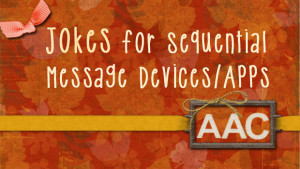
Between the craziness of the election, the stress of Superstorm Sandy, some frustration over some blog issues, and the pace of getting ready for the ASHA convention, we were ready for a little levity. It seemed like just the time to rustle up some jokes that could be programmed on an SGD, an AAC app, or a sequential message device. If you need a laugh, too, here’s a list of places to check out for some jokes that may work for the AAC learners you know. Jokes for Every Season – From Ducksters Knock Knock Jokes – From Funology More Knock Knock Jokes – A whole website full of them Jokes by Category – From Activity Village Why Did the Chicken Cross the Road? Jingle Jokes from Kelly Martin Christmas Jokes from the Nurture Store Photo courtesy of Silver Lining Multimedia via Picture This Pro
Filed under: PrAACtical Thinking
Tagged With: humor, jokes, sequential message device, SGD
November 26, 2012
by Carole Zangari -
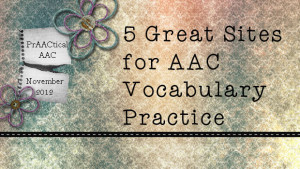
We’re always happy to find sites that can be used to solidify new word learning. Once we completed a variety of activities for explicit instruction on new vocabulary, we start thinking about adding in some practice activities. Repetition with variety keeps the learners engaged and helps them cement their understanding of the target words. No more ‘learning to pass the quiz, then forgetting it all.’ With some extra effort, we can help our AAC friends hang onto the new knowledge that they’ve gained. Here are are some sites that you can use to create fun practice activities. Make acrostic poems with the target words Find related words with Word Hippo See how the target word relates to other concepts with Wordsift: Type the vocabulary word into the box to see a semantic web unfold. Explore a bunch of vocabulary games at Wordia Make a digital bulletin board around the new... [Read More...]
Filed under: PrAACtical Thinking
Tagged With: semantics, vocabulary, vocabulary practice, websites for vocabulary
November 23, 2012
by Carole Zangari -
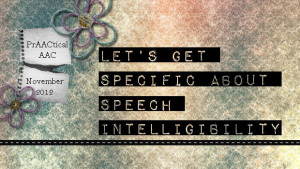
When we’re writing AAC evaluation reports, compiling funding documents, and summarizing the present level of performance in IEPs, we frequently comment on speech intelligibility. In some cases, we’ve administered a standardized assessment instrument and are sharing those results. Often, though, the comments are more descriptive in nature. It is not uncommon to read documentation in which someone with articulation difficulties is described as having speech intelligibility that is mildly, moderately, or severely impaired. Those categories are pretty broad, open to interpretation, and can be quite vague. What do we really mean when saying that someone does or doesn’t have intelligible speech? To narrow down the meaning, we specify the two variables that have the greatest influence on how comprehensible the communicator’s speech output actually is: the context and the communication partner. Specifying whether the context is known and the partner is a familiar one, helps us better interpret the descriptors... [Read More...]
Filed under: PrAACtical Thinking
Tagged With: documentation, report writing, speech intelligibility
November 22, 2012
by Carole Zangari -

Filed under: PrAACtical Thinking
Tagged With: appreciation, thankful, Thanksgiving
November 20, 2012
by Robin Parker -
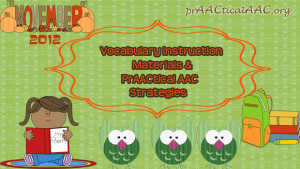
We are super big fans of Teachers Pay Teachers (TPT). We need the PrAACtical resources that TPT offers. In addition to paying ridiculously low prices for some great teaching materials and cool classroom resources, there are also many free options. Check out these free vocabulary resources and have lots of fun. As always, the materials are only as good as the teaching strategies that go with them. As we check out these awesome vocabulary resources, we will use the following guiding principles and we will create appropriate communication opportunities for ALL learners to participate in direct vocabulary instruction. Active Participation for Everyone– Make sure all learners can make choices within the activity, respond to questions, add information, request clarification, and even ask for a break if they need it. To do this we will need one hit message devices, visual supports, individual and group communication displays, choice boards, switches, etc.... [Read More...]
Filed under: PrAACtical Thinking
Tagged With: vocabulary instruction, vocabulary materials & resources
November 20, 2012
by Carole Zangari -
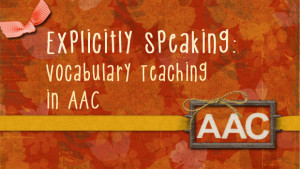
An essential part of the model we shared for AAC semantic intervention is Step 2, teaching the new words with explicit instruction activities. In our posts, explicit instruction refers to the process of designing and using carefully planned sequence of empirically-supported teaching activities. Though focused on reading, not vocabulary, development, this PowerPoint presentation by Dr. Anita Archer gives an excellent overview of the characteristics of explicit instruction. In our initial teaching of new words, we to be sure that the learners have frequent opportunities to respond: Active participation is critical at this point. We have to give the learner a lot of opportunities to say the word (e.g.,“resume”) and tell about it (e.g., “keep going,” “start again and not stop,” “verb”, etc.). We want to elicit a lot of responses so that we can monitor their performance. That allows us to provide feedback that is affirmative when the learners respond... [Read More...]
Filed under: PrAACtical Thinking
Tagged With: implementation ideas, new word learning, semantics, teaching, teaching activities, vocabulary
November 19, 2012
by Carole Zangari -
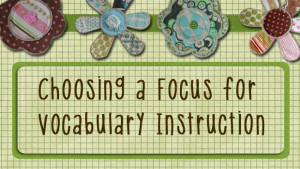
In writing our posts on vocabulary teaching, we came across a host of vocabulary materials, games, apps, activities, lesson plans, worksheets, and websites. Some were by SLPs, but the majority were by general education teachers, teachers of English as a second language, and special education teachers. No matter what the age, grade level, or instructional setting, they all shared the same focus: teaching the meaning of new words. At first glance, that makes sense. But learning the meaning of new words is just the beginning. There are other, equally important things to focus on in vocabulary instruction that go beyond learning the meaning of new vocabulary words. Beyond learning the meaning of brand new words (“I understand it when I hear it.”), we can help learners to: • Develop a deeper understanding of known words (“I understand different aspects of this word.” “I know many different ways to use this... [Read More...]
Filed under: PrAACtical Thinking
Tagged With: broader lexicon, intervention, language intervention, lexical diversity, new word learning, semantics, vocabulary
November 18, 2012
by Carole Zangari -
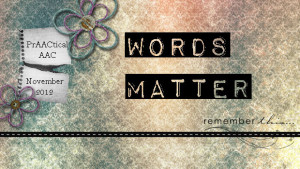
For anyone who doesn’t see how vocabulary instruction can possibly be a priority for kids who have intellectual disabilities or multiple disabilities, A short video with a gentle reminder… Words matter. For everyone. Click image for video.
Filed under: PrAACtical Thinking
Tagged With: vocabulary
November 16, 2012
by Robin Parker -
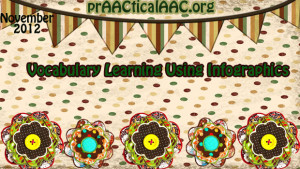
Infographics are a great way to explore vocabulary. Learners can make choices, view and comment, and even create their own infographics about words and topics. Check out these great infographics that can be used for vocabulary instruction. The key though is to use language facilitation and vocabulary instructions strategies to facilitate learning. 5 Words Visualized for Fun Direct Vocabulary Instruction Vacation Trucks Firefighters Photosynthesis Accolade (downloadable poster) & 3 Tools to Create Your Own Vocabulary Infographics With Your Students
Filed under: PrAACtical Thinking
Tagged With: Infographics, Instruction, vocabulary
November 15, 2012
by Robin Parker -

Part of TEACHING vocabulary to AAC users (or any learner) involves reinforcement. Reinforcement is more than just facilitating positive self esteem. It is also about providing feedback that will help increase the skill you are trying to teach. It’s even more than learning specific new words but also about strategies to attack learning new words outside of the therapy or classroom environment. Below are some examples of ways to make the most of your reinforcement and some ways to NOT. 🙂 SAY THIS… General Principles of Reinforcement for Vocabulary: Be specific to the goal. Use words that explain the skill you want to occur more often. Use excited positive vocal inflection, Be impressed! We are continuing with the example of teaching the word consumed from Carole’s post on Monday, What Makes A Good Vocabulary Teaching Activity. ‘Wow you discovered a NEW WAY of saying take in, you used consumed’! ‘Awesome... [Read More...]
Filed under: PrAACtical Thinking
Tagged With: Learning, reinforcement, vocabulary









